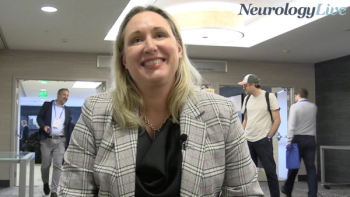
Shorter Ocrelizumab Infusion Accepted for FDA Review
The FDA has accepted an sBLA for a version of Genentech's ocrelizumab with a shorter administration time for the treatment of relapsing and primary progressive MS.
Levi Garraway, MD, PhD
Genentech has announced that both the FDA and EMA have accepted supplemental applications for review for a new 2-hour ocrelizumab (Ocrevus) infusion that would be administered 2 times per year for those with relapsing or primary progressive multiple sclerosis (MS).
The supplemental biologics license application (sBLA) was accepted by the FDA based on data from the ENSEMBLE PLUS study, a double-blind, prospective substudy to the open-label, single-arm, phase 3b ENSEMBLE (NCT03085810) trial. The data suggest that the 2-hour infusion time has a comparable frequency and severity of infusion-related reactions (IRRs) to the currently approved 3.5-hour infusion time in those with relapsing-remitting MS.
Genentech noted that detailed data from the study will be presented at the earliest opportunity. The FDA and the European Commission are expected to make decisions on these applications by the end of the year.
“With more than 150,000 people treated with OCREVUS, the twice-yearly dosing schedule has benefited many MS patients and their physicians, as indicated by more than 90% of patients [based on US PharMetrics commercial claims] continuing with treatment through 1 year,” said Levi Garraway, MD, PhD, chief medical officer and head of Global Product Development, Roche. “We hope a shorter infusion time will further improve the experience for people living with MS while also increasing capacity in healthcare systems.”
WATCH NOW:
In ENSEMBLE PLUS, the therapy was assessed in the approved administration schedule of two 3.5-hour, 300-mg infusions separated by 2 weeks, compared to second and later 600-mg doses administered over 2 hours. The primary end point was the proportion of patients with IRRs following the first randomized 600-mg infusion, with frequency and severity assessed during infusion and 24-hours afterward. There were no discontinuations due to an IRR and no new safety signals were detected.
Ocrelizumab was approved as the first of its kind in the treatment of primary progressive MS in 2017. In January, the FDA updated the
In February, at the Americas Committee for Treatment and Research in Multiple Sclerosis (ACTRIMS) Forum, February 27-29, 2020, in West Palm Beach, Florida, data were presented from an open-label assessment of the OPERA 1 (NCT01247324) and OPERA 2 (NCT01412333) studies, which showed that those with relapsing MS who initiated ocrelizumab treatment earlier reported better rates of 24-week confirmed disability progression (CDP24) and relapse compared with those who received initial interferon treatment.3
After a 4-year study period, the group who continued on ocrelizumab treatment (OCR-OCR) had an annualized relapse rate (ARR) decrease from 0.13 to 0.05, while those who switched to ocrelizumab from interferon ß-1a (IFN-OCR) had a decrease from 0.20 to 0.04. From pre-switch to years 1, 2, 3, and 4 post-switch, AAR decreased from 0.20 to 0.10, 0.08, 0.07, and 0.04, respectively, among IFN-OCR patients. Compared with OCR-OCR continuers, ARR was maintained at a lower rate at pre-OLE and through the 4 years of the OLE period (0.13, 0.10, 0.08, 0.07, 0.05). In addition to the lower ARR, ORC-ORC continuers had lower proportions of patients with CDP24 in the year pre-switch, and at OLE year 1 and years after when compared to IFN-OCR switchers. In the year pre-switch, 7.7% of OCR-OCR continuers had CDP24, compared to 12% of IFN-OCR switchers. The trend continued in OLE year 1 (10.1% vs 15.6%), OLE year 2 (13.9% vs 18.1%), OLE year 3 (16.2% vs 21.3%) and OLE year 4 (19.2% vs 23.7%; P <.05).
To hear more about the data presented at this year's ACTRIMS Forum, Clyde E. Markowitz, MD, gave NeurologyLive a review in light of 6-year follow-up data with ocrelizumab therapy. Watch below.
REFERENCES
1. US FDA and EMA accept applications for Roche’s OCREVUS (ocrelizumab) shorter 2-hour infusion time [press release]. Basel, Switzerland: Genentech; Published April 20, 2020. Accessed April 20, 2020. globenewswire.com/news-release/2020/04/20/2018330/0/en/US-FDA-and-EMA-accept-applications-for-Roche-s-OCREVUS-ocrelizumab-shorter-2-hour-infusion-time.html
2. Drug Safety-related Labeling Changes (SrLC). US FDA website. January 15, 2020. Accessed April 20, 2020. accessdata.fda.gov/scripts/cder/safetylabelingchanges/index.cfm.
3. Hauser SL, Kappos L, Giovannoni G, et al. Long-term reduction of relapse rate and confirmed disability progression after 6 years of ocrelizumab treatment in patients with relapsing MS. Presented at 2020 ACTRIMS forum. February 27-29, 2020; West Palm Beach, Florida. Abstract P064.
Newsletter
Keep your finger on the pulse of neurology—subscribe to NeurologyLive for expert interviews, new data, and breakthrough treatment updates.




































